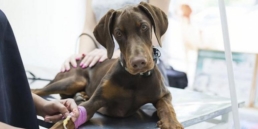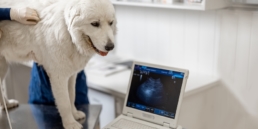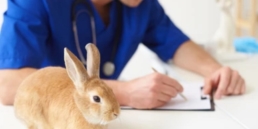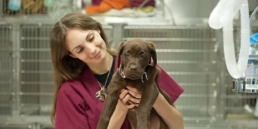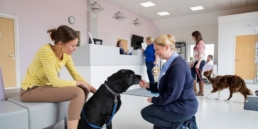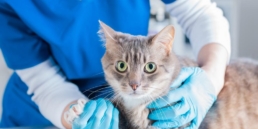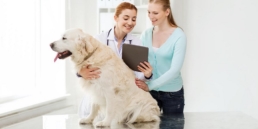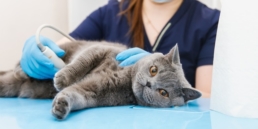Veterinary Images: Making Sharing Seamless
Imaging is a vital part of veterinary medicine. Radiographs, ultrasound scans, CT scans, and MRIs are among the most common veterinary images that you will use in practice. These images will also be used by and shared with many practice stakeholders, such as radiographers, radiologists, in-house specialists, referral partners, and sometimes even patients. Therefore, it is vital to have a way to share them quickly and without any hiccups.
Certain issues might be associated with the sharing of veterinary images, including:
- Privacy and confidentiality
- Sharing must be done in compliance with state laws that govern the transmission of medical information of animals.
- Differences in image viewing capabilities
- Different image types require viewers with certain specifications. If the image viewers of the receiving parties do not have these, they will be unable to view the image.
- Inconsistencies in reporting platforms and techniques
- Just as image viewers may differ, reporting platforms and practices can also vary.
- Size limitations
- Unwanted compressions that result in changes in the image quality
- Delays caused by waiting for one person to finish working on/reporting the image
Essential considerations for image sharing
Digital Imaging and Communications in Medicine (DICOM) is the standard for stringing and sharing medical imaging information and other related data. It was specially developed to solve problems associated with the transferring and sharing of medical images. Before its development, it was difficult to decode the images created by medical imaging devices. This problem has been solved with its creation, and images from machines produced by different manufacturers can be easily transmitted.
Since veterinary images fall under the umbrella of medical images, they are also usually DICOM compliant. Therefore, the picture archiving and communication system (PACS) being used by your practice must support DICOM images, as well as non-DICOM images.
The PACS should also address other issues. For example, it should not compromise the image’s quality or size. It should be easily accessible by all people who need access to it, and it should enable multiple people to view and work on the images simultaneously.
The Asteris Keystone PACS Suite
The Asteris Keystone PACS suite was specifically designed for veterinary practices as a holistic solution for veterinary image storage and communication needs. It makes the process of image sharing seamless in various ways, including:
- Sharing and transferring: It enables you to share DICOM and non-DICOM images of any modality with multiple facilities, colleagues, referral partners, and clients. The process is easy and requires only a few clicks of the mouse.
- Viewing: The integrated DICOM image viewer enables you to retrieve and review images, aiding you in making accurate diagnoses. It also has advanced features, such as a 2D multi-planar reconstruction that will enable you to reconstruct images in multiple planes. This will help improve your diagnostic accuracy.
- Security: It provides the automatic archiving, encrypting, and storing of your veterinary images on cloud-based servers. You no longer have to worry about the security of the images that you are sending.
- Integration: The PACS can easily be integrated into your diagnostic equipment, radiology information system, and practice management software. It even works with other DICOM-compliant image viewers from other providers. It will work with your existing hardware and does not require you to purchase any dedicated hardware for its use.
- Reporting: The PACS comes with reporting features that enable you to standardize your reports across the board. There are numerous time-saving features, such as speech-to-text conversion and pre-designed templates. You can also create your custom templates for reporting.
- Advanced teleconsultation workflow: This enables all the different stakeholders who will need to interact with your veterinary images to send consultations easily and provides a reporting platform for responses. This keeps all your files in one central, easily accessible location.
- Hybrid architecture: By providing local image archival and automatic off-site backups of image data, the PACS enables you to achieve better lossless image compression, preserving the integrity of your files.
Final Thoughts
Since images form an essential part of the daily activities of veterinary practices, it is vital to have a system in place that makes the sharing and handling of these veterinary images safe, secure, and seamless. The Asteris Keystone PACS suite has all the features that you need.
Here at Asteris, it's our goal to help veterinarians make sound medical decisions with ease, clarity, and confidence by giving them the tools and insights that they need to optimize the way they work.
If you're ready to stop feeling like there's not enough time in your day, we can help you optimize your imaging processes and the way you work. Contact our specialists today to get started!
Veterinary Radiology and Ultrasound: 10 Enhancements to Look Forward To
Veterinary radiology and ultrasound scans are vital parts of your practice. As a veterinarian or a practice manager, you must ensure that you can maximally utilize the images that you obtain. One crucial way of doing this is by harnessing technology.
Many everyday tasks associated with imaging are carried out in your practice, including:
- Reviewing images after they are captured
- Collaborating with other specialists or radiologists for referrals or second opinions
- Comparing images captured at different times to assess disease progression/regression
- Creating notes and reports based on images
- Storing the images in a safe and easily accessible location
Therefore, it is essential to have things in place that will enable you to perform these daily tasks with ease. Otherwise, they can cause frustration and various issues, including:
- Delays in reporting that can subsequently lead to delays in establishing diagnoses
- Delays in patients receiving care
- Data leaks and breaches due to a lack of safe storage and data protection
- System failures and loss of information that is not stored or backed up correctly
The Asteris Keystone Suite
Asteris is a company centered on creating solutions that fit the needs of veterinary practices. Its team believes that having effective solutions in place can have a cascading effect on the way that you do business and can markedly improve your outcomes.
The Asteris Keystone picture archiving and communication system (PACS) was created explicitly for veterinary practices, to provide solutions for all their veterinary radiology and ultrasound needs. A PACS that can integrate all your image processing and handling requirements into an easy-to-use and readily available solution will be a great addition to your veterinary practice. It will result in a marked improvement in your practice’s efficiency and productivity.
Ten Enhancements the Asteris Keystone PACS Suite Brings to Your Practice
- Remote access: The Asteris Keystone online app enables you to access your images on any kind of device, anywhere, and at any time. This means you do not have to wait to go into the office to view patients’ images.
- Collaboration and consultation: With Asteris Keystone Community, every step of the referral and consultation process, including viewing of images, making diagnoses, and reporting, is streamlined.
- Archive and secure data: The PACS provides a means for archiving, encrypting, and securely storing your data, both locally and automatically off-site in a cloud-based platform. You will also receive monthly reports that show your archiving activities, study dates, and patient information.
- Advanced teleconsultation workflow: It has an advanced telecommunications workflow that enables radiologists, specialists, and other practice stakeholders to expand their keystone PACS solution to provide a full teleconsultation and reporting platform.
- Image transferring and sharing: It enables you to transfer, share, and retrieve images and information and effortlessly creates reports using speech-to-text features and predesigned report templates. Its patented file packaging methods mean that the image transfer speeds are faster than most other systems. It supports multiple image modalities and allows you to view both Digital Imaging and Communications in Medicine (DICOM) and non-DICOM images with its built-in image viewer.
- Integration: It can be seamlessly integrated with your existing diagnostic equipment, practice management software, and radiology information system.
- Scheduling and monitoring: The Modality Worklist/Scheduling feature enables you to schedule exams for your patients and monitor the status of these exams
- Image recovery: It enables you to recover lost or damaged data if your local files become corrupted or lost.
- User-friendly interface: The suite has an intuitive and user-friendly interface, so no extensive training period is required.
- Easy installation and setup: Since the solutions are designed to work on non-proprietary hardware, there is no need to buy any dedicated hardware. Simply use what you already have. Asteris will also provide you with support during the installation and launch process.
The Asteris Keystone suite is an excellent tool for improving the processes associated with your veterinary radiology and ultrasound images. There are no monthly or annual subscription fees; it operates a “pay-as-you-use” model. It can be customized to suit your practice size and can be as extensive or as simple as you would like. Emergency client support is available 24/7 for clients at no extra cost, providing you with a means to solve any issues that might come up.
Here at Asteris, it's our goal to help veterinarians make sound medical decisions with ease, clarity, and confidence by giving them the tools and insights that they need to optimize the way they work.
If you're ready to stop feeling like there's not enough time in your day, we can help you optimize your imaging processes and the way you work. Contact our specialists today to get started!
5 Time Management Tips for Vet Practice Managers
Most veterinarians work for over forty hours a week. They also have to respond to emergencies during weekends and outside their usual working hours. Unfortunately, vets are not the only employees who work for extended hours in a veterinary practice. Other staff members also need to stay in the office to attend to patients. Lacking proper time management methods can affect your practice in many ways. First, you will incur more costs paying overtime, which leads to lower revenue. Second, serving all patients within the scheduled time may be tricky, leading to frustration and lost clients. Poor time management also overwhelms your staff and lowers their productivity. Here are five time management tips for practice managers that you can leverage.
1. Delegate Tasks
Failing to assign work among employees is a major issue in most vet practices. This problem leads to confusion and time wastage because some staff members may be unsure about the tasks that they should handle.
It can also cause conflicts when some employees feel that others are not delivering as they should. Another problem that arises due to task delegation failure is employees handling work outside their job description.
Improve time management in your vet practice by ensuring that each member on your team understands their role. An ideal way to implement this measure is by using detailed job descriptions when hiring. You should also encourage employees to consult you if they don’t understand a task within their position.
Also, while delegating many jobs to one person may reduce costs, it wastes time and leads to inefficiencies. It can also affect operations if one employee misses work due to issues like sickness.
A suitable way to avoid this issue is by having well-trained staff for each role and department. Hire part-time technicians and vets to fill in when people are absent.
2. Leverage Technology
The lack of suitable software wastes time in many veterinary practices. If you identify that your patients need more than the average duration for appointments, you likely have inefficient systems.
Improve management by assessing all processes to identify those consuming too much time. Then, look for software solutions to speed them up. Ideal tools should also come with several practice management features to reduce costs.
Imaging is an integral process in diagnosing and treating patients, but this process can waste time and cause delayed treatments. Invest in digital solutions to avoid these issues and improve accuracy. Companies like Asteris provide comprehensive imaging software to support securing and sharing files.
Adopting such tools will speed up service delivery and simplify work for your team. It also improves time management because you can predict how long specific processes will take.
3. Ensure That Pet Owners Arrive on Time
Pet owners who arrive late for their appointments waste time for your team and other clients. They also mess up workflow schedules, causing employees to stay beyond the needed hours.
As a practice manager, you must ensure that pet owners come for their appointments at the right times. One ideal strategy is sending reminders one day and several hours before the session. Also, consider implementing a late fee that gradually increases based on the caused delay.
4. Have an Emergency Department
Pet emergencies are a significant time management issue in many practices. When there is a severely injured or critically ill animal, vets may leave other patients. They may also have to postpone appointments to conduct emergency surgeries.
Having a pet emergency department will simplify handling such matters and prevent neglecting some patients. It also streamlines workflow because each section can handle specific cases and have delegated employees. Another benefit of including an emergency department is reducing pressure on your veterinarians.
5. Embrace Teleconsultation
Diagnosing pets consumes time, especially if they need multiple tests. This process may also be complicated when you have a significant number of patients and few specialists.
Embracing teleconsulting is ideal for reducing the time needed to identify health issues in animals. This move also gives you more experience and a better understanding of various health issues.
When considering teleconsultation, you should look for a veterinary tool that supports the process. It will give you easier access to industry specialists despite your location. A collaborative veterinary solution also simplifies attending to many patients in a day and saves time for your practice and pet owners.
Use These Time Management Tips for Practice Managers
Applying various time management tips for practice managers can help you reduce costs. You also avoid frustrating clients, encouraging them to continue seeking your services. Asteris provides an imaging solution to help you improve time management. This tool enables you to access diagnostic images from any device. It also has file-sharing features to support collaboration and consultation.
Here at Asteris, it's our goal to help veterinarians make sound medical decisions with ease, clarity, and confidence by giving them the tools and insights that they need to optimize the way they work.
If you're ready to stop feeling like there's not enough time in your day, we can help you optimize your imaging processes and the way you work. Contact our specialists today to get started!
5 Insights for Better Veterinary Practice Management
Research shows that the veterinary market has a value of over 44 billion. Experts also predict that the demand for these services will grow by about 3.8% in 2022. While a larger market means more revenue and profit, it can also lead to many problems.
When client numbers increase, managing a veterinary practice can become more difficult. If you don't apply effective control measures, you will likely offer slow services. This issue will lead to losing your clients to competitors and having incurring losses.
Here, we provide insights for veterinary practice management by discussing five methods that you can use.
1. Invest in Technology
Managing your vet practice without the right tools can be tricky for various reasons. First, you will need more time to register patients and pet owners. Processing payments manually and writing invoices can be tedious.
Simplify vet practice management by adopting suitable software. Assess all departments to identify time-consuming processes. Consult your employees to determine if they need help with specific procedures.
Based on this information, find software solutions to speed up these processes and avoid unnecessary paperwork. If you are unsure about the tools that you need, liaise with IT experts to identify them. These professionals can also help you choose tools to speed up service delivery within your budget.
Cybersecurity is a critical issue for most healthcare providers, including vet practices. Failure to protect client data can lead to breaches and harm your reputation. When looking for technology to help you manage your practice, prioritize safety.
An ideal solution should feature authentication to limit access to patients' data. It should also protect files during sharing to prevent unauthorized people from accessing them.
2. Give the Best Veterinary Experience
One common problem in many vet practices is dealing with unsatisfied pet owners. While it may be tempting to ignore some raised concerns and focus on service delivery, this issue can affect your office in many ways.
First, unsatisfied clients may harm your reputation by giving negative reviews. This will then lead to you having to spend more money on marketing and damage control.
Avoid such problems by providing the ultimate experience. Ensure that pet owners can access medical information about their pets. Streamline frustrating processing like billing and check-in. It's also advisable to respond to all concerns promptly and fix identified issues.
More ways to give the best veterinary experience include:
- Give a warm reception.
- Consult pet owners before choosing treatment methods.
- Have active emergency phone numbers.
Most pet owners base their experiences on how vets handle them and their pets. Improve client satisfaction by using various methods to ensure that animals feel comfortable during their visits.
For example, reward positive behavior and calm patients during diagnosis. Use less-invasive imaging equipment to reduce anxiety. You can also provide your clients tips on managing aggressive animals and preparing them for vet visits.
3. Keep Your Team Happy
Having an efficient vet practice team can simplify operations. Before hiring someone, examine their credentials to ensure that you are recruiting the right talent. It's also advisable to assess soft skills and gauge if they would get along with your current practice team.
Unhappy employees can frustrate clients in many ways. For example, they may be less productive, causing pet owners to waste time during visits. Others may offer poor-quality services, increasing complaints and the time needed to solve them.
Maintain a happy team by conducting regular follow-ups and addressing raised concerns. Provide incentives to do good work, thus boosting employee satisfaction.
4. Invest in Marketing
A significant churn rate can lead to management issues and income losses. Market your vet practice to promote growth and achieve a steady income flow. First, determine the most suitable campaigns based on your targeted market, income, and other demographics.
Next, liaise with marketing companies to make strategies and increase awareness about your services. These measures will help you identify methods that deliver desirable results at a relatively low price.
Offering discounts and promotions when marketing your vet practice can improve management. This move will motivate current clients to recommend your office to other pet owners. Ultimately, it will be easier to maintain more clients with less marketing effort.
5. Partner with Other Vets
One way to improve vet practice management is by partnering with other experts in the field. This move will speed up diagnosing patients and ensure that you offer appropriate treatments. It also reduces the risk of errors that can lead to lawsuits or worsen your pet patients' health.
Support collaboration and consultations by getting DICOM solutions that enable you to share files. Implement solutions with teleconsultation features to simplify managing multiple vet practices from one location.
Apply These Insights for Veterinary Practice Management
Employing the discussed insights for veterinary practice management will ease your work. You will also reduce costs in the long run and improve revenue generation. Asteris provides imaging software to help you with vet practice management.
Here at Asteris, it's our goal to help veterinarians make sound medical decisions with ease, clarity, and confidence by giving them the tools and insights that they need to optimize the way they work.
If you're ready to stop feeling like there's not enough time in your day, we can help you optimize your imaging processes and the way you work. Contact our specialists today to get started!
How to Reduce No-Show Veterinary Appointments
Did you know that approximately 27% of pet owners don't take their animals to the vet every year? A significant number do make appointments but fail to show up. Unfortunately, clients failing to attend their sessions has various consequences.
First, it reduces vet practices’ revenues, leading to losses if costs are more than income. Second, it wastes resources and your veterinary practice team’s time.
While getting a 100% show-up rate is difficult, you can apply various methods to reduce no-shows. This measure will also help you forecast revenues and budget accordingly.
Here, we discuss five strategies that you can use to reduce no-show veterinary appointments. We also explain ways to implement various policies while avoiding negative results, like losing clients.
1. Request a Deposit
One ideal way to reduce no-show veterinary appointments is by asking pet owners to pay a deposit when booking their sessions. This amount can be a percentage of the expected cost. For instance, if you charge $50 for a routine checkup, you may request $10 as a deposit.
If a client doesn't specify the services that they need, you can ask them to pay a percentage of the consultation fee.
The main benefit of requiring a deposit is it reduces the number of unsure clients booking appointments. It also simplifies scheduling your day because you can quickly determine the number of patients to expect.
2. Charge a No-Show Fee
Some pet owners don't prioritize vet visits and miss them due to being busy with other activities. Others postpone critical procedures like getting a vaccination, risking their animals' health.
Charging a no-show fee is a suitable way to reduce missed appointments. Since implementing such a policy can lead to pushback, it's vital to notify your clients beforehand.
Create newsletters and emails explaining the reason for this move. Mention the amount that you will charge as a no-show fee, and specify if it will apply to all types of appointments.
Share these missives with your clients and ask them to confirm delivery. It's also advisable to request their feedback and to respond to all concerns.
When implementing a no-show fee, it's best to offer a grace period. This measure will give pet owners a certain amount of time to notify you if they can't make it to the session.
An ideal grace period should be approximately two or three days, though you can offer twenty-four- or twelve-hour exemptions for those who can't show up due to emergencies.
3. Send Appointment Reminders
While most pet owners fail to attend appointments due to alternative activities, others simply forget their sessions. If you experience this issue in your practice, get software with reminder features. Then, ask your clients to install the solution and help them set it up.
You may send reminders the day of the appointment or several hours before the scheduled time. You can also utilize pop-up notifications to ensure that pet owners will get the messages even when they do not log into the app.
Sending appointment reminders is a simple way to reduce no-shows while showing your clients that you care. This measure also helps you boost engagement and encourages pet owners to use your other vet practice software features. These may include billing and accessing electronic medical records.
4. Call Pet Owners before Their Appointments
While sending reminders can lower veterinary no-shows, it may not be fully effective. Some pet owners may not check their phones regularly. The best way to increase show-up rates is by complementing text reminders with phone calls.
Keep a detailed record of booked appointments and include pet owners' phone numbers. Then, liaise with your staff to contact clients the day before their visits. This step will help you determine if they are aware of their appointment day and time.
You can also provide special instructions for preparing the pet for various procedures. For instance, if they need surgery, ask the owner to ensure that the pet fasts for the recommended period. Alternatively, inform them to bring their pet’s favorite toys to reduce anxiety during checkups.
5. Encourage Online Booking
Booking appointments physically or on a call can lead to confusion. Pet owners may not recall the time or date and then fail to show up for the session.
If your clients constantly forget their appointments, get a solution that supports online booking. Such software will enable them to confirm their session. They can also use it to determine when they last visited your office and book appointments at suitable times.
Another benefit of a solution with an online booking feature is that it gives pet owners easy access to medical records. This prevents missing referral visits when they forget to carry hardcopy reports.
Get Practice Software to Reduce No-Show Veterinary Appointments
Adopting the proper practice software can reduce no-shows. Asteris has a solution to simplify managing a veterinary office. With its tool, you can streamline the diagnosis and referring of patients.
These best practices will ultimately improve patient experiences and lower the number of forgetful pet owners who don’t show up for their appointments.
Here at Asteris, it's our goal to help veterinarians make sound medical decisions with ease, clarity, and confidence by giving them the tools and insights that they need to optimize the way they work.
If you're ready to stop feeling like there's not enough time in your day, we can help you optimize your imaging processes and the way you work. Contact our specialists today to get started!
Integrated DICOM Image Viewer for Efficient Vets
Research shows that the demand for veterinary imaging will grow at a cumulative rate of 7% from 2021 to 2026. This means its market value will rise from $1.6 to $2.3 billion. One factor leading to the rise in demand for this technology is the high adoption of diagnostic imaging.
Using veterinary imaging also helps practices lower costs and avoid using film processors. While this technology has many benefits, vets can still find it tough to analyze their images. Also, using a viewer that's not compatible with referral partners' tools affects consultation.
Getting a DICOM image viewer, like the one provided by Asteris, can help you avoid such issues. This tool will simplify image sharing and management for your team. Here, we explore various ways to boost efficiency with the Asteris Keystone integrated DICOM viewer.
How the Asteris Keystone DICOM Viewer Improves Veterinary Practice Efficiency
Adopting the Asteris Keystone DICOM viewer can help you boost vet practice efficiency and lower costs in many ways. First, it enables you to access images taken during tests from any device, regardless of your location. This aspect makes it easier to analyze test images even when out of the office.
Studying images when diagnosing patients can be time-consuming and make it challenging to offer timely treatment and manage minor health issues. Adopting the Asteris Keystone DICOM viewer enables you to ease the diagnosis process.
This solution has image reconstruction to turn 2D and 3D images into multiple plane ones. With this tool, you can quickly identify abnormalities and offer treatment to avoid adverse health issues. It's also possible to prevent misdiagnosing pet patients and harming your practice's reputation.
Another way that the image reconstruction tools can improve efficiency is by lowering recovery time, which will then reduce costs for your patients and vet practice.
Leverage Referrals with Asteris DICOM Viewer
When diagnosing your patient or assessing treatments, you may need a second opinion. Consulting other vets or referring your patients to them can help you identify conditions faster. It also allows you to boost the quality of your care and prescribe effective treatments.
Despite these benefits, most vets find it difficult to consult other experts. One reason is that lacking proper image-sharing tools makes it hard to collaborate.
Fortunately, you can leverage the benefits of consultation and referrals with Asteris Keystone. This solution enables you to share DICOM and non-DICOM images to other platforms. This aspect means you can avoid printing hard copies and speed up the referral process. It also enables you to collaborate with vets worldwide, irrespective of the imaging software that they use.
Sharing large images can slow down services, especially if you run multiple vet practices. Such an issue will also affect your ability to offer emergency medical care. Getting the Asteris imaging software and its DICOM viewer will prevent such problems, as well as boost your efficiency. These solutions can reduce image sizes by more than 50% without lowering the quality. Therefore, you can share many images at one time without worrying about slow uploads.
Enhance Reporting with Asteris Keystone
After attending to a pet patient, you need to create a medical report for future reference. Unfortunately, that process can consume a great deal of your time. Creating this document also makes it more challenging for you to manage your practice with many clients and affects the quality of your services.
The Asteris DICOM image viewer comes with various features to help you avoid the stress associated with reporting. First, the solution has predesigned templates that contain various essential sections, including the patients' details, health conditions, vitals, and test results. With these templates, you can reduce the time needed to design and fill a report. You may also customize the document to meet the needs of your practice and pet patients.
Second, you can boost efficiency in your vet practice with the speech-to-text compatibility. This feature enables you to convert audio recorded during sessions into detailed written documents. Using it avoids the extra cost of getting transcription software or hiring someone for these services.
By adopting the Asteris DICOM image viewer, you simplify work for your staff. It’s also possible to focus more on treating pet patients than on creating documentation.
Improve Data Security
Your medical database contains sensitive pet patient information. It may also have details about your clients, such as:
- Their name
- Credit card information
- Addresses
- Contact details
- Payment History
If this information leaks due to a security breach, it will severely affect your practice. Such an issue may also cause you to lose patients' images and medical files.
Getting the DICOM image viewer from Asteris can help you protect your data. The solution comes with security tools to limit file access. It also has algorithms to enforce authentication and prevent others from modifying your files.
Improve Veterinary Efficiency with Asteris DICOM Image Viewer
Getting the Asteris Keystone DICOM image viewer will boost vet efficiency. This solution comes with many features to simplify sharing files and consultation. These will help you offer better treatment and avoid issues that may affect your practice.
Here at Asteris, it's our goal to help veterinarians make sound medical decisions with ease, clarity, and confidence by giving them the tools and insights that they need to optimize the way they work.
If you're ready to stop feeling like there's not enough time in your day, we can help you optimize your imaging processes and the way you work. Contact our specialists today to get started!
PACS Radiology Improving Veterinary Workflows
As a practice manager, you know that your workflow goes a long way in determining the efficiency of your processes and patient care methods in your veterinary practice. It can be frustrating to perform necessary but low-yield tasks, such as filing and sorting documents, leaving you with insufficient time to perform more high-value work.
There are two main categories that you can examine to find out why your workflows may be inefficient: your performers and your systems. Performers include people involved in your workflows, such as doctors, radiologists, radiographers, pharmacists, or even third-party vendors. Systems are the software or technologies, such as your imaging tools or image management software, that you use to handle tasks related to your workflow.
Benefits of an Efficient Workflow
When correctly set up, your workflow should be easily repeatable with minimum effort from those using it. Conversely, an inefficient workflow will need constant monitoring and attention and will require more effort to maintain.
Having an efficient workflow will reduce the time that your practice stakeholders will spend working through time-consuming but necessary tasks, reduce costs, improve staff efficiency, and enhance communication between all the different departments, employees, consultants, and other stakeholders.
Benefits of an efficient workflow include the following:
- It eliminates the waste of time, effort, and money.
- It ensures that your resources are being allocated to the appropriate places.
- By automating specific tasks and providing a standard method of doing things, it reduces the occurrence of human error.
- It improves the overall output of your team and the quality of your work.
How Can Good Imaging Tools Improve Your Workflow?
In veterinary practice, the recording, storage, and usage of radiological images is an integral part of your workflow; therefore, investing in good imaging tools is crucial for efficient workflow.
Good imaging tools can improve your workflow by:
- Providing better image resolutions: This ensures that even after transferring and other image manipulation techniques, the resolutions of the images are still outstanding.
- Increasing diagnostic speed and accuracy: Since these tools have higher and more efficient processing capabilities, they can help improve the speed and accuracy of diagnoses.
- Improving image storage and transfer: Good imaging tools come with advanced ways of storing and transferring images.
- Saving time: Since good imaging tools work efficiently and require less time to work than less-efficient ones, the time that they can save your practice will add up in the long run.
How Do Picture Archiving and Communication System (PACS) Image Management Tools Improve Your Workflow?
In addition to having good imaging tools, you should have a system that enables the proper handling of your images. The Asteris PACS radiology image management workflow solutions are priceless tools for your veterinary practice.
The Asteris Keystone Product Suite is a PACS radiology image management solution designed specifically for veterinary practices. One of the core beliefs of the Asteris team is that changing your imaging workflow can have a cascading positive impact on the way that you do business, and they have committed to helping you achieve this.
There are many benefits associated with Asteris’s solution:
- Access and sharing: It improves the ease of access to the images and enables you to store effortlessly, transfer, and share DICOM and non-DICOM images of any modality.
- Image retrieval and handling: Asteris Keystone has an integrated DICOM image viewer, enabling you to review images and make diagnoses. The 2D multi-planar reconstruction ability is an advanced feature that will enable you to reconstruct your images in different views, enhancing your diagnostic accuracy.
- Communication and collaboration: Its advanced telecommunication workflow ensures that there will be smoother collaboration and communication between practice stakeholders. The Asteris Keystone community streamlines communication and collaboration processes among all your practice stakeholders, including doctors, radiologists, practice managers, and event clients.
- Integration: It can be easily connected to your existing practice management software, and you don’t need to buy any special hardware to use it.
- Report creation: It comes with built-in templates that make recording results and creating reports smoother and more manageable. It also enables you to convert speech to text, create your own templates, and perform many other essential tasks.
Why Choose the Asteris Keystone PACS Solution?
First, there are no service contracts or annual maintenance fees. It operates a simple “pay-as-you-use” model. This enables you to choose the features that you would like for your practice and only pay for what you use.
Second, technical support, software updates, and software upgrades are provided for you free of charge. In addition to routine technical support, technical representatives are available twenty-four hours a day, seven days a week, to attend to emergencies.
Concluding Thoughts
Good imaging tools can lead to marked improvements in the workflow of any veterinary practice. Having a sound PACS radiology system to go hand-in-hand with these tools is essential.
The Asteris Keystone PACS is the ideal solution for veterinary practices, and it can be tailored to fit your practice requirements, no matter what they are!
Here at Asteris, it's our goal to help veterinarians make sound medical decisions with ease, clarity, and confidence by giving them the tools and insights that they need to optimize the way they work.
If you're ready to stop feeling like there's not enough time in your day, we can help you optimize your imaging processes and the way you work. Contact our specialists today to get started!
Imaging Technology Impacting Veterinary Care
Veterinary care has undergone many improvements over the years. Diagnoses have become more accurate, the workflow processes have advanced, and the service delivery has improved.
While various factors are responsible for these evolutions, the singular most important factor is the industry-wide adoption of more innovative technology, especially those used in imaging.
The specific ways through which the deployment of technology is impacting veterinary care include:
- Secure and advanced data management and retrieval
- Automation and digitization of manual processes
- Seamless and efficient workflow
- Improved diagnostic features
- Advanced tele-consultation and collaborative capabilities
Read on to learn how these features of advanced imaging technology positively impact veterinary care and how to incorporate them into your practice.
How Imaging Technology Is Impacting Veterinary Care
1) Secure and Advanced Data Management and Retrieval
Imaging data is one of the most important tools utilized by veterinary specialists. Internal scans of patients present experts with valuable data that can aid the diagnosis of the patient's conditions. As a result, specialists should secure the imaging data and guarantee its proper management.
However, advanced imaging technology handles this without any extra effort from the veterinary staff. Once the scanning device produces the visual data, the high-powered software sees its automatic archival and backup, providing permanent storage in the process. In essence, there is the assurance of no future data losses.
Furthermore, whenever there is a need to access the data, the imaging technology provides effortless retrieval.
2) Automation and Digitization of Manual Processes
Before advanced imaging tools, a great deal of physical effort went into managing imaging data, including capturing visuals, processing, filing, and eventual storage. However, seamless and automated backup of files eliminates all of these tasks.
Whenever there is the need to recall the data, the technology also eliminates the laborious efforts that go into sorting huge numbers of physical files.
Vet staff can repurpose the time saved for more purposeful tasks than physical file management.
3) Seamless and Efficient Workflow
Many processes go into each image processing and final diagnostic work. Administering everything the traditional way only creates slow and inefficient systems. Improved imaging technology automatedly handles duties such as sorting and assigning tasks, reporting, and filing. This reduced workload enables vet practitioners to increase the amount of work done per day, thereby boosting business productivity and earnings.
4) Improved Diagnostic Features
Most imaging technologies are made to capture, process, and store visual data. They add significant value to the diagnostic process, having advanced features that enhance the ability of the specialist to arrive at more accurate findings.
For instance, 3D imaging makes it possible to visualize the data from multiple dimensions, while artificial intelligence systems can make quantitative evaluations of radiographic data.
These features significantly reduce the propensity for misdiagnoses and other human errors.
5) Advanced Tele-consultation and Collaborative Capabilities
Advanced imaging systems have made it possible to carry out diagnostic and other medical tasks anywhere. A specialist having to be present to undertake any function is no longer mandatory.
Cutting-edge imaging solutions with teleradiology features facilitate the smooth sharing of data, making it possible for experts to collaborate on any project, even though they may not share physical proximity. This is a great value-add, especially in an increasingly remote-working world.
How to Improve Your Veterinary Care through Imaging Technology
Having become aware of the benefits of imaging technology in veterinary care, you as a vet practitioner need to know what to look out for when selecting an imaging technology provider.
1) Flexible Offerings
You need a provider that enables you to be flexible with your choice of services. For instance, the provider should not fix storage capacity and pricing arrangements. Furthermore, you should be able to select which features to handpick and which to exclude. You need access to multiple imaging formats and standards and accessibility to data on numerous devices.
2) Versatile Data Management
There is a need for multiple data management options on flexible offerings, especially regarding storage systems. While cloud-based archival is highly desirable, it is not devoid of limitations like the sudden loss of the internet. Absolute dependence on only one system may lead to undesirable outcomes. In addition to the cloud, having remote and on-site storage is highly advisable.
3) Advanced Next-Generation Features
Having the latest tools and resources in medical imaging should be an essential factor in selecting a provider. For instance, you may look for the presence of 3D tech and artificial intelligence systems. Computer-aided detection mechanisms are also value-adds.
4) Seamless Integration with Legacy Technology
In deploying new radiographic technology, you don't want to disband all available systems, as doing this would disrupt ordinary workflow. Instead, it is best to go for a service provider that can blend with traditional imaging devices and systems.
Final Thoughts
Integrating modern and sophisticated imaging systems has the potential to supercharge your vet practice. The benefits of greater productivity, more accurate diagnoses, automation, and improved chances for increased earnings are too attractive to bypass.
Therefore, selecting a credible provider of these technologies is crucial. One such excellent brand is Asteris. With its suite of services, you are assured of a full range of features coupled with premium service delivery.
Here at Asteris, it's our goal to help veterinarians make sound medical decisions with ease, clarity, and confidence by giving them the tools and insights that they need to optimize the way they work.
If you're ready to stop feeling like there's not enough time in your day, we can help you optimize your imaging processes and the way you work. Contact our specialists today to get started!
 North America
North America Asia/Pacific
Asia/Pacific Europe
Europe